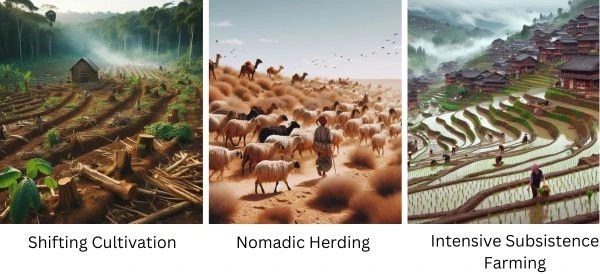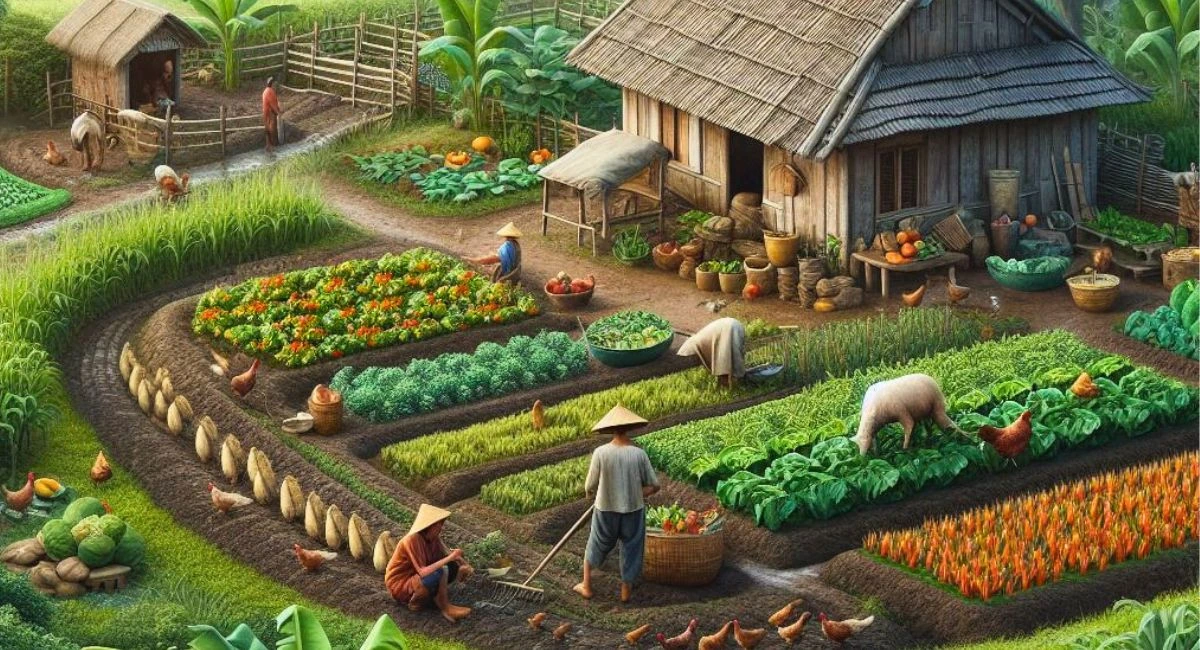Subsistence farming is one of the oldest forms of agricultural practice, deeply rooted in the traditional rural life of India and many other developing regions. This farming method focuses on producing enough crops and livestock to meet the needs of the farmer and their family, with little or no surplus for trade. Despite its simplicity, this practice sustains millions of families worldwide, particularly in rural and underdeveloped regions.
What Is Subsistence Farming?
Subsistence farming is a self-sufficient agricultural system where farmers grow food primarily to meet their family’s needs rather than for commercial sale. It typically involves small plots of land, traditional farming techniques, and minimal use of modern machinery.
Farmers cultivate crops like rice, maize, and vegetables and often rear livestock such as chickens and goats. Any surplus produce is usually traded locally. The focus is on sustenance, not profit, making it distinct from large-scale commercial farming.
Features
- Small Land Holdings: Farming is conducted on small plots of land, often inherited and fragmented across generations.
- Family-Oriented Farming: Family members provide most of the labor, with limited or no hired workforce.
- Traditional Tools and Techniques: Simple tools such as hoes and sickles are used instead of advanced machinery.
- Diverse Crop Cultivation: Multiple crops like rice, maize, vegetables, and pulses are grown to ensure a steady food supply.
- Minimal Market Interaction: The primary focus is to produce food for the family’s consumption, with little or no surplus for the market.
- Mixed Farming Practices: Farmers often rear livestock like goats, cows, and chickens alongside crop cultivation for additional food security.
- Dependence on Rainfall: Irrigation facilities are minimal, making farming heavily dependent on natural rainfall.
- Organic Practices: The limited use of fertilizers and pesticides often results in naturally organic produce.
- Low Productivity: Due to small land sizes, traditional techniques, and minimal inputs, the yield per unit of land is generally low.
- Self-Sufficiency: The primary aim is sustenance rather than profit, making the system self-reliant but economically limited.
One defining feature of subsistence farming is the small size of the landholdings. Families often cultivate small plots of inherited land, which may be insufficient to produce significant yields.
Farmers rely on traditional practices, including the use of simple tools such as hoes and plows, and natural fertilizers like compost and manure, rather than chemical inputs.
Another important aspect is the diversity of crops grown. Farmers cultivate a variety of plants to ensure year-round food availability, reducing the risk of food shortages caused by crop failure.
Labor is usually provided by family members, with farming becoming a collective effort that strengthens family bonds. These features reflect the simplicity and sustainability of subsistence farming, which continues to support millions of rural families worldwide.
Types of Subsistence Farming

Subsistence farming can be categorized into several types based on the region and practices:
- Shifting Cultivation: This type involves clearing forested land for farming and moving to new plots once the soil fertility declines. It is common in tropical regions but is increasingly criticized for its environmental impact.
- Primitive Subsistence Farming: Relies heavily on natural resources and simple tools.
- Intensive Subsistence Farming: Practiced in densely populated regions, particularly in Asia, this type involves the cultivation of small plots of land with high labor input to maximize yields, often using irrigation to grow staple crops like rice.
- Nomadic Herding: In arid and semi-arid areas, farmers raise livestock such as sheep, camels, and goats, moving them seasonally to find fresh pastures and water sources. This method is essential for communities that depend on animal products.
Importance
Subsistence farming plays a crucial role in ensuring food security for millions of people worldwide. For families in remote areas with limited access to markets, it is often the only reliable source of food.
It also contributes to the preservation of traditional farming knowledge, which includes practices adapted to specific climates and ecosystems. Furthermore, subsistence farming promotes biodiversity.
Unlike commercial farming, which focuses on monoculture, subsistence farmers grow multiple crops and rear diverse livestock. This diversity helps maintain ecological balance, improves soil fertility, and reduces vulnerability to pests and diseases.
Subsistence vs. Commercial Farming
Subsistence farming differs significantly from commercial farming in its objectives and practices. While subsistence farming prioritizes family sustenance, commercial farming is profit-oriented, focusing on the large-scale production of crops for sale.
The tools and techniques also vary; subsistence farming relies on traditional methods, while commercial farming employs advanced machinery, irrigation systems, and fertilizers to boost productivity.
However, subsistence farming can sometimes complement commercial farming. For instance, surplus produce from subsistence farms can enter local markets, providing additional income for farmers while supporting local economies.
Challenges Faced by Farmers
Despite its benefits, this type of farming faces several challenges that hinder its sustainability and growth. One of the most pressing issues is the scarcity of resources. Small landholdings, poor soil quality, and limited access to water constrain farmers’ ability to produce enough food.
Climate change further exacerbates these challenges. Unpredictable weather patterns, such as prolonged droughts or excessive rainfall, disrupt crop cycles and lead to food shortages. Farmers often lack the knowledge and resources to adopt climate-resilient farming practices, leaving them vulnerable to environmental changes.
Another major challenge is economic isolation. Subsistence farmers are typically disconnected from larger agricultural markets, which limits their ability to sell surplus produce or access quality seeds and fertilizers. Without proper support from governments or organizations, these farmers struggle to break the cycle of poverty.
Role in Rural Development
Despite its limitations, subsistence farming remains vital for rural development. It provides a livelihood for millions of families and supports the local economy by sustaining communities in remote areas.
Promoting traditional practices and biodiversity also contributes to environmental conservation. Organizations and governments can play a significant role in improving the sustainability of subsistence farming.
Initiatives such as providing access to affordable tools, quality seeds, and training programs can help farmers increase productivity while maintaining ecological balance.
Policies that connect subsistence farmers to local markets can also enhance their economic prospects.
Future of Subsistence Farming
To ensure its survival in the modern era, subsistence farming must adapt to changing circumstances. Integrating traditional knowledge with modern agricultural techniques can help farmers overcome challenges like resource scarcity and climate variability.
For example, adopting simple technologies such as drip irrigation and organic pest control can significantly boost productivity. Additionally, empowering subsistence farmers through education and financial support can create opportunities for innovation and growth.
Governments must recognize the importance of subsistence farming in food security and rural livelihoods, implementing policies that address the specific needs of smallholder farmers.
Relevance in the Modern Era
Despite the challenges, subsistence farming remains significant in rural areas where farmers have limited resources. Governments and agricultural organizations are increasingly supporting these farmers by providing training, modern tools, and access to improved seeds.
In conclusion, Subsistence farming is more than just an agricultural practice; it is a way of life for millions of families worldwide. Its significance in ensuring food security, preserving traditional knowledge, and promoting environmental sustainability cannot be overstated.
However, it also faces considerable challenges that require immediate attention. Whether as a foundation for food security or a contributor to rural development, subsistence farming will continue to play a vital role in global agriculture.

